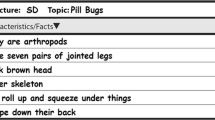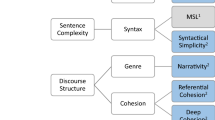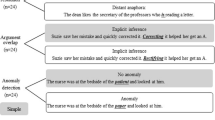Abstract
Direct instruction of reading strategies, such as the ‘structure strategy’, is demonstrated to be effective for the development of more mature and skilled reading processes in struggling readers. This instructional intervention approach, aimed at directly improving reading ability, can be used in combination with text simplification. Text simplification is the modification of the text in order to make it more understandable or readable for target groups of readers. In this article, we discuss a theoretically-driven text simplification approach, inspired by cognitive models of reading comprehension. Differently from classical approaches to linguistic text simplification, the aim of cognitive text simplification is not simply to reduce the linguistic complexity of the text, but to improve text coherence and the structure of information in the text. This can be achieved by using rhetorical devices, like signaling or discourse markers, which specify relationships among ideas at a global level (macrostructural) and work as processing instructions for the reader, scaffolding reading comprehension. The goal of this paper is to discuss, in light of the literature, the effectiveness of these adaptations for improving struggling readers’ understanding and learning from informational texts.
Similar content being viewed by others
References
American Psychiatry Association. (2013). Diagnostic and statistical manual of mental disorders-DSM-5. Washington, DC: American Psychiatry Association.
Arfé, B., Oakhill, J., & Pianta, E. (2014). Text simplification in TERENCE. In T. Di Mascio, R. Gennari, P. Vittorini, R. Vicari, & F. De la Prieta (Eds.), Methodologies and intelligent Systems for technology enhanced learning. Advances in intelligent systems and computing (Vol. 292, pp. 165–172). Heidelberg: Springer.
Arfé, B., Oakhill, J., & Pianta, E. (2016) Text simplification and its effects on young poor readers. ELN (European Literacy Network) COST IS140 meeting, Nicosia, Cyprus, 4–5 November 2016.
Bamberg, M. (1987). The acquisition of narratives. Learning to use language. Berlin: De Gruyter.
Benjamin, R. (2012). Reconstructing readability: Recent developments and recommendations in the analysis of text difficulty. Educational Psychology Review, 24, 63–88.
Britton, B. K., & Gulgoz, S. (1991). Using Kintsch’s computational model to improve instructional text: Effects of repairing inference calls on recall and cognitive structures. Journal of Educational Psychology, 83, 329–345.
Buell, S. (2015). A commentary on “First-hand experience of accessible information”. Tizard Learning Disability Review, 20, 88–91. doi:10.1108/TLDR-12-2014-0042.
Cain, K., & Oakhill, J. (2006). Profiles of children with specific reading comprehension difficulties. British Journal of Educational Psychology, 76, 683–696. doi:10.1348/0007099056x67610.
Cain, K., Oakhill, J., & Bryant, P. (2004). Children’s reading comprehension ability: Concurrent prediction by working memory, verbal ability, and component skills. Journal of Educational Psychology, 96(1), 31–42. doi:10.1037/0022-0663.96.1.31.
Cain, K., Patson, N., & Andrews, L. (2005). Age- and ability-related differences in young readers’ use of conjunctions. Journal of Child Language, 32(4), 877–892. doi:10.1017/s0305000905007014.
Carretti, B., Borella, E., Cornoldi, C., & De Beni, R. (2009). Role of working memory in explaining the performance of individuals with specific reading comprehension difficulties: A meta-analysis. Learning and Individual Differences, 19(2), 246–251. doi:10.1016/j.lindif.2008.10.002.
Carroll, J., Minnen, G., Pearce, D., Canning, Y., Devlin, S., & Tait, J. (1999). Simplifying text for language-impaired readers. In Proceedings of the 9th conference of the European chapter of the ACL (EACL’99), Bergen, Norway.
Cataldo, M. G., & Oakhill, J. (2000). Why are poor comprehenders inefficient searchers? An investigation into the effects of text representation and spatial memory on the ability to locate information in text. Journal of Educational Psychology, 92, 791–799.
Catts, H. W., Adlof, S. M., & Weismer, S. E. (2006). Language deficits in poor comprehenders: A case for the simple view of reading. Journal of Speech Language and Hearing Research, 49(2), 278–293. doi:10.1044/1092-4388(2006/023).
Catts, H. W., Hogan, T. P., & Fey, M. E. (2003). Subgrouping poor readers on the basis of reading-related abilities. Journal of Learning Disabilities, 36, 151–164.
Chambliss, M. J. (2002). The characteristics of well-designed science textbooks. In J. Otero, J. A. Leon, & A. C. Graesser (Eds.), The psychology of science text comprehension (pp. 51–72). Mahwah, NJ: Erlbaum.
Chandrasekar, R., & Srinivas, B. (1997). Automatic induction of rules for text simplification. Knowledge Based Systems, 10(3), 183–190.
Cordova, J., Sinatra, G. M., Broughton, S. H., Taasoobshirazi, G., & Lombardi, D. (2014). Self-efficacy, confidence in prior knowledge, and conceptual change. Contemporary Educational Psychology, 39, 164–174.
Crossley, S. A., Allen, D., & McNamara, D. S. (2012). Text simplification and comprehensible input: A case for an intuitive approach. Language Teaching Research, 16(1), 89–108. doi:10.1177/1362168811423456.
Crossley, S. A., Greenfield, J., & McNamara, D. S. (2008). Assessing text readability using cognitively based indices. Tesol Quarterly, 42(3), 475–493.
Crossley, S. A., Louwerse, M. L., McCarthy, P. M., & McNamara, D. S. (2007). Alinguistic analysis of simplified and authentic texts. Modern Language Journal, 91(2), 15–30.
Dale, E., & Chall, J. S. (1948). A formula for predicting readability. Educational Research Bulletin, 27(11–20), 37–54.
De Belder, J., & Moens, M. F. (2010). Text simplification for children. In Proceedings of the SIGIR workshop on accessible search systems, Geneva, 23 July 2010, pp. 19–26, ACM.
De la Prieta, F., Di Mascio, T., Gennari, R., Marenzi, I., & Vittorini, P. (2014). User centred and evidence based design: The TERENCE experience. International Journal of Technology Enhanced Learning, 6(3), 212–236.
Denton, C. A., Enos, M., York, M. J., Francis, D. J., Barnes, M. A., Kulesz, P. A., et al. (2015). Text-processing differences in adolescent adequate and poor comprehenders reading accessible and challenging narrative and informational text. Reading Research Quarterly, 50(4), 393–416. doi:10.1002/rrq.105.
Diakidoy, I. A. N., Kendeou, P., & Ioannides, C. (2003). Reading about energy: The effects of text structure in science learning and conceptual change. Contemporary Educational Psychology, 28(3), 335–356. doi:10.1016/s0361-476x(02)00039-5.
Diakidoy, I. A. N., Mouskounti, T., & Ioannides, C. (2011). Comprehension and learning from refutation and expository texts. Reading Research Quarterly, 46(1), 22–38. doi:10.1598/rrq.46.1.2.
Dyck, N., & Pemberton, J. B. (2002). A model for making decisions about text adaptations. Intervention in School and Clinic, 38(1), 28–35.
Englert, C. S., Tarrant, K. L., Mariage, T. V., & Oxer, T. (1994). Lesson talk as the work of reading groups: The effectiveness of two interventions. Journal of Learning Disabilities, 27, 165–185. doi:10.1177/002221949402700305.
Fajardo, I., Avila, V., Ferrer, A., Tavares, G., Gomez, M., & Hernandez, A. (2014). Easy-to-read texts for students with intellectual disability: Linguistic factors affecting comprehension. Journal of Applied Research in Intellectual Disabilities, 27(3), 212–225. doi:10.1111/jar.12065.
Fajardo, I., Tavares, G., Avila, V., & Ferrer, A. (2013). Towards text simplification for poor readers with intellectual disability: When do connectives enhance text cohesion? Research in Developmental Disabilities, 34(4), 1267–1279. doi:10.1016/j.ridd.2013.01.006.
Freyhoff, G., Hess, G., Kerr, L., Menzel, E., Tronbacke, T., & Van Der Veken, K. (1998). Make it simple: European guidelines for the production of easy-to-read information for people with learning disability for authors, editors, information providers, translators and other interested persons. ILSMH European Association (International League of Societies for Persons with Mental Handicap). Retrieved from http://www.inclusion-europe.org/uploads/doc/99.pdf
García, J. R., Bustos, A., & Sánchez, E. (2015). The contribution of knowledge about anaphors, organisational signals and refutations to reading comprehension. Journal of Research in Reading, 38(4), 405–427. doi:10.1111/1467-9817.12021.
Graesser, A. C., McNamara, D. S., Cai, Z. Q., Conley, M., Li, H. Y., & Pennebaker, J. (2014). Coh-metrix measures text characteristics at multiple levels of language and discourse. Elementary School Journal, 115(2), 210–229. doi:10.1086/678293.
Guthrie, J. T., & Davis, M. H. (2003). Motivating struggling readers in middle school through an engagement model of classroom practice. Reading and Writing Quarterly, 19, 59–85.
Guzzetti, B. J., Snyder, T. E., Glass, G. V., & Gamas, W. S. (1993). Promoting conceptual change in science: A comparative meta-analysis of instructional interventions from reading education and science education. Reading Research Quarterly, 28, 117–159.
Hayes, D. P., Wolfer, L. T., & Wolfe, M. F. (1996). Schoolbook simplification and its relation to the decline in SAT-verbal scores. American Educational Research Journal, 33(2), 489–508. doi:10.3102/00028312033002489.
Hebert, M., Bohaty, J. J., Nelson, J. R., & Brown, J. (2016). The effects of text structure instruction on expository reading comprehension: A meta-analysis. Journal of Educational Psychology, 108(5), 609–629. doi:10.1037/edu0000082.
Hu, M., & Nation, I. S. P. (2000). Vocabulary density and reading comprehension. Reading in a Foreign Language, 23, 403–430.
Hynd, C. (2003). Conceptual change in response to persuasive messages. In G. M. Sinatra & P. R. Pintrich (Eds.), Intentional conceptual change (pp. 291–315). Mahwah, NJ: Lawrence Erlbaum Associates.
International Federation of Library Associations and Institutions, & IFLA Section of Libraries Serving Disadvantaged Persons. (1997). Guidelines for easy-to-read materials. Hague: International Federation of Library Associations and Institutions.
Karreman, J., Van Der Geest, T., & Buursink, E. (2007). Accessible website content guidelines for users with intellectual disabilities. Journal of Applied Research in Intellectual Disabilities, 20(6), 510–518.
Kincaid, J. P., Fishburne, R. P., Rogers, R. L., & Chissom, B. S. (1975). Derivation of new readability formulas (Automated Readability Index, Fog Count and Flesch Reading Ease Formula) for Navy enlisted personnel. Research Branch Report 8–75, Millington, TN: Naval Technical Training, U.S. Naval Air Station, Memphis, TN.
Kintsch, W. (1988). The use of knowledge in discourse processing: A construction-integration model. Psychological Review, 95, 163–182.
Kintsch, W., & van Dijk, T. A. (1978). Towards a model of text comprehension and production. Psychological Review, 85, 363–394.
Leroy, G., Endicott, J. E., Kauchak, D., Mouradi, O., & Just, M. (2013). User evaluation of the effects of a text simplification algorithm using term familiarity on perception, understanding, learning, and information retention. Journal of Medical Internet Research, 15(7), 191–203. doi:10.2196/jmir.2569.
Leroy, G., Kauchak, D., & Hogue, A. (2016). Effects on text simplification: Evaluation of splitting up noun phrases. Journal of Health Communication, 21, 18–26. doi:10.1080/10810730.2015.1131775.
Linderholm, T., Everson, M. G., van den Broek, P., Mischinski, M., Crittenden, A., & Samuels, J. (2000). Effects of causal text revisions on more and less skilled readers? Comprehension of easy and difficult text. Cognition and Instruction, 18, 525–556.
Locke, J. (2003). The plain language movement. Journal of the American Medical Writers Association, 18, 5–8.
Lorch, R. F., Jr., & Lorch, E. P. (1995). Effects of organizational signals on text-processing strategies. Journal of Educational Psychology, 87, 537–544.
Lorch, R. F., & Lorch, E. P. (1996). Effects of headings on text recall and summarization. Contemporary Educational Psychology, 21, 261–278.
Lorch, R. F., Lorch, E. P., & Inman, W. E. (1993). Effects of signaling topic structure on text recall. Journal of Educational Psychology, 85(2), 281–290. doi:10.1037//0022-0663.85.2.281.
Lovett, M. W., Borden, S. L., WarrenChaplin, P. M., Lacerenza, L., DeLuca, T., & Giovinazzo, R. (1996). Text comprehension training for disabled readers: An evaluation of reciprocal teaching and text analysis training programs. Brain and Language, 54(3), 447–480. doi:10.1006/brln.1996.0085.
Mason, L., Baldi, R., Di Ronco, S., Scrimin, S., Danielson, R. W., & Sinatra, G. M. (2017). Refutation text and graphics: Effects on conceptual change learning. Contemporary Educational Psychology, 49, 275–288.
Mason, L., & Gava, M. (2007). Effects of epistemological beliefs and learning text structure on conceptual change. In S. Vosniadou, A. Baltas, & X. Vamvakoussi (Eds.), Reframing the conceptual change approach in learning and instruction (pp. 165–196). Oxford: Elsevier.
Mason, L., Gava, M., & Boldrin, A. (2008). On warm conceptual change: The interplay of text, epistemological beliefs, and topic interest. Journal of Educational Psychology, 100, 291–309. doi:10.1037/0022-0663.100.2.291.
McNamara, D. S., Graesser, A. C., & Louwerse, M. M. (2012). Sources of text difficulty: Across genres and grades. In J. P. Sabatini, E. Albro, & T. O’Reilly (Eds.), Measuring up: Advances in how we assess reading ability (pp. 89–116). Lanham, MD: R&L Education.
McNamara, D. S., Kintsch, E., Songer, N. B., & Kintsch, W. (1996). Are good texts always better? Interactions of text coherence, background knowledge, and levels of understanding in learning from text. Cognition and Instruction, 14(1), 1–43. doi:10.1207/s1532690xci1401_1.
McNamara, D. S., Louwerse, M. M., McCarthy, P. M., & Graesser, A. C. (2010). Coh-metrix: Capturing linguistic features of cohesion. Discourse Processes, 47(4), 292–330. doi:10.1080/01638530902959943.
Meyer, B. J. F. (2003). Text coherence and readability. Topics in Language Disorders, 23(3), 204–224.
Meyer, B. J. F., Brandt, D. M., & Bluth, G. J. (1980). Use of the top-level structure in text: Key for reading comprehension of ninth-grade students. Reading Research Quarterly, 16, 72–103.
Meyer, B. J. F., & Poon, L. W. (2001). Effects of structure strategy training and signaling on recall of text. Journal of Educational Psychology, 93(1), 141–159. doi:10.1037/0022-0663.93.1.141.
Meyer, B. J. F., Wijekumar, K., Middlemiss, W., Higley, K., Lei, P. W., Meier, C., et al. (2010). Web-based tutoring of the structure strategy with or without elaborated feedback or choice for fifth- and seventh-grade readers. Reading Research Quarterly, 45(1), 62–92. doi:10.1598/rrq.45.1.4.
Mich, O., & Vettori, C. (2011). E-stories for educating deaf children in literacy. Description and evaluation of the DAMA procedure. Technical Report, LODE project, 2011, http://lode.fbk.eu/pubblicazioni.html
Mikkilä-Erdmann, M. (2001). Improving conceptual change concerning photosynthesis through text design. Learning and Instruction, 11, 241–257.
Morgan, M. F., & Moni, K. B. (2008). Literacy: Meeting the challenge of limited literacy resources for adolescents and adults with intellectual disabilities. British Journal of Special Education, 35, 92–101.
Nomura, M., Nielsen, G. S., Tronbacke, B. I., & International Federation of Library Associations and Institutions. (2010). Guidelines for easy-to-read materials/rev. The Hague: IFLA Headquarters.
Ouellette, G., & Beers, A. (2010). A not-so-simple view of reading: How oral vocabulary and visual-word recognition complicate the story. Reading and Writing, 23(2), 189–208. doi:10.1007/s11145-008-9159-1.
Sanders, T. J. M., & Noordman, L. G. M. (2000). The role of coherence relations and their linguistic markers in text processing. Discourse Processes, 29(1), 37–60. doi:10.1207/S15326950dp2901_3.
Schmitt, N., Jiang, X., & Grabe, W. (2011). The percentage of words known in a text and reading comprehension. The Modern Language Journal, 95, 26–43. doi:10.1111/j.1540-4781.2011.01146.x.
Scott, C. M., & Balthazar, C. H. (2010). The grammar of information challenges for older students with language impairments. Topics in Language Disorders, 30(4), 288–307. doi:10.1097/TLD.0b013e3181f90878.
Sinatra, G. M., & Broughton, S. W. (2011). Bridging reading comprehension and conceptual change in science education: The promise of refutation text. Reading Research Quarterly, 46, 374–393.
Smith, B. L., Holliday, W. G., & Austin, H. W. (2010). Students’ comprehension of science textbooks using a question-based reading strategy. Journal of Research in Science Teaching, 47(4), 363–379. doi:10.1002/tea.20378.
Smith, D., Stenner, A. J., Horabin, I., & Smith, M. (1989). The Lexile scale in theory and practice. Final report. Washington, DC: MetaMetrics (ERIC Document Reproduction Service No. ED307577).
Spires, H. A., & Donley, J. (1998). Prior knowledge activation: Inducing engagement with informational texts. Journal of Educational Psychology, 90, 249–260.
Stanovich, K. E. (1994). Does dyslexia exist? Journal of Child Psychology and Psychiatry, 35(4), 579–595. doi:10.1111/j.1469-7610.1994.tb01208.x.
Stoodley, C. J., Ray, N. J., Jack, A., & Stein, J. F. (2008). Implicit learning in control, dyslexic and garden-variety poor readers. Annals of the New York Academy of Sciences, 1145, 173–183.
Tippett, C. D. (2010). Refutational text in science education. A review of two decades of research. International Journal of Science and Mathematics Education, 8, 951–970.
Trabasso, T., & Nickels, M. (1992). The development of goal plans of action in the narration of a picture story. Discourse Processes, 15(3), 249–275.
van den Broek, P., & Kendeou, P. (2008). Cognitive processes in comprehension of science texts: The role of co-activation in confronting misconceptions. Applied Cognitive Psychology, 22, 335–351.
Van Silfhout, G., Evers-Vermeul, J., & Sanders, T. (2015). Connectives as processing signals: How students benefit in processing narrative and expository texts. Discourse Processes, 52, 47–76. doi:10.1080/0163853X.2014.905237.
Vidal-Abarca, E., Martinez, G., & Gilabert, R. (2000). Two procedures to improve instructional text: Effects on memory and learning. Journal of Educational Psychology, 92, 107–116.
Welie, C., Schoonen, R., Kuiken, F., & van den Bergh, H. (2016). Expository text comprehension in secondary school: For which readers does knowledge of connectives contribute the most? Journal of Research in Reading, 00, 1–24. doi:10.1111/1467-9817.12090.
Wijekumar, K., Meyer, B. J. F., & Lei, P. (2017). Web-based text structure strategy instruction improves seventh graders’ content area reading comprehension. Journal of Educational Psychology, 109(6), 741–760. doi:10.1037/edu0000168.
Wijekumar, K., Meyer, B. J. F., Lei, P., Lin, Y., Johnson, L. A., Spielvogel, J. A., et al. (2014). Multisite randomized controlled trial examining intelligent tutoring of structure strategy for 5th-grade readers. Journal of Research on Educational Effectiveness, 7, 331–357. doi:10.1080/19345747.2013.853333.
Williams, J. P., Stafford, K. B., Lauer, K. D., Hall, K. M., & Simonne, P. (2009). Embedding reading comprehension training in content area instruction. Journal of Educational Psychology, 101(1), 1–30.
World Wide Web Consortium. (2008). Web content accessibility guidelines (WCAG) 2.0. Retrieved May 19, 2017 form https://www.w3.org/TR/WCAG20/
Author information
Authors and Affiliations
Corresponding author
Rights and permissions
About this article
Cite this article
Arfé, B., Mason, L. & Fajardo, I. Simplifying informational text structure for struggling readers. Read Writ 31, 2191–2210 (2018). https://doi.org/10.1007/s11145-017-9785-6
Published:
Issue Date:
DOI: https://doi.org/10.1007/s11145-017-9785-6




